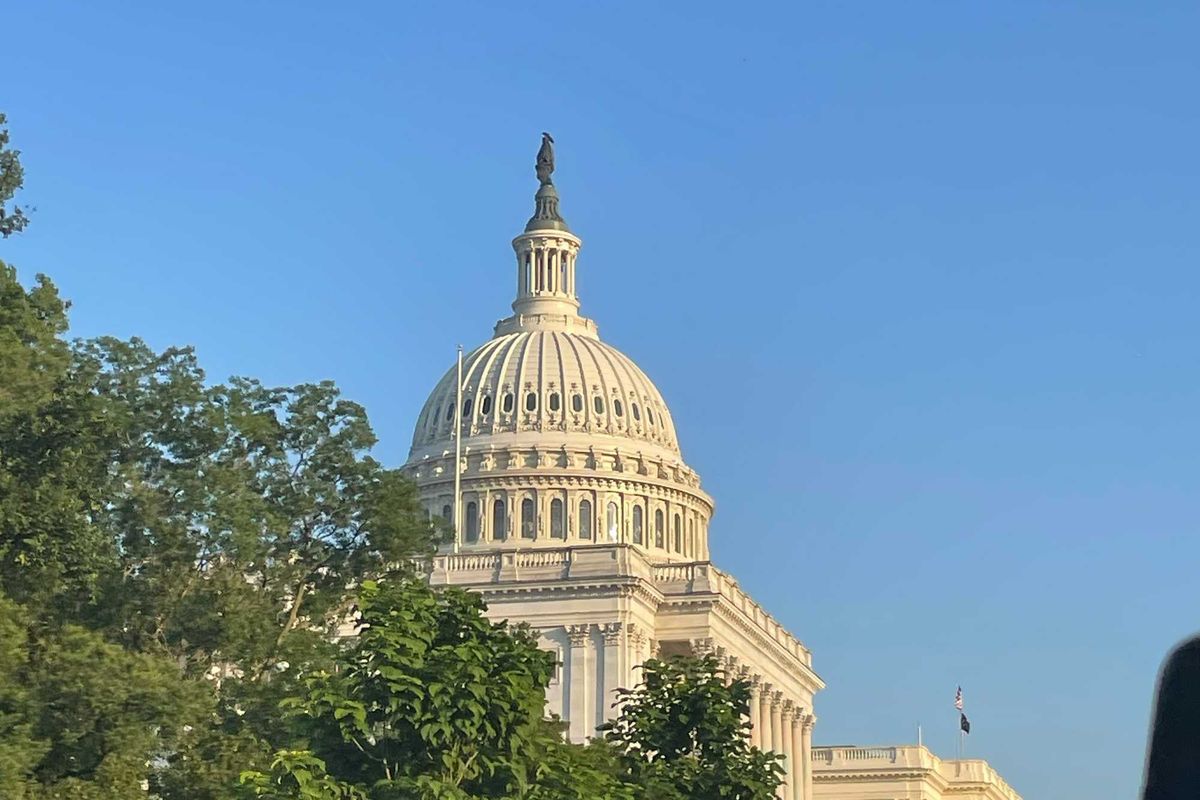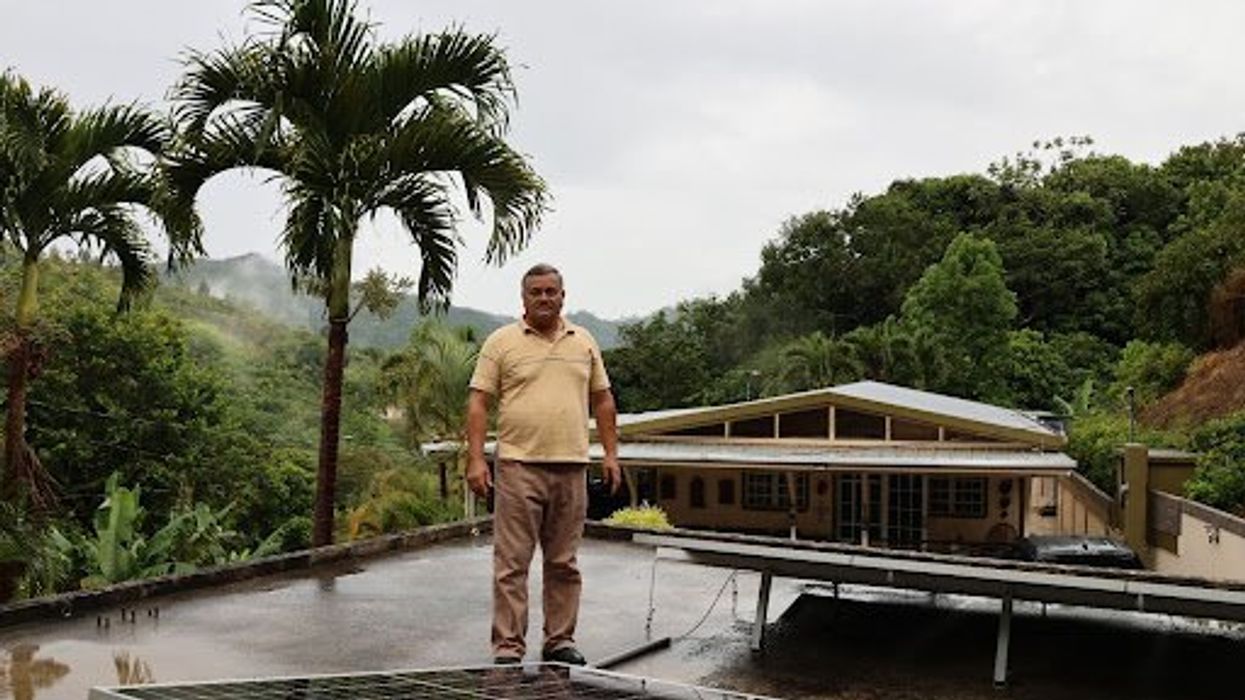In this two-part series, Lily Carey reports on energy instability in rural Puerto Rico and its impact on residents with chronic medical conditions. Faced with limited government support, community members have begun building their own power structures from the ground up, ranging from solar microgrids to community health clinics.
In Part One, Carey reports on the lasting impacts of Hurricane Maria and how mismanagement of Puerto Rico’s electric grid in the years since has led to ongoing instability.
Luz María Torres Sierra walked into her bedroom, switching on the light and gesturing to a tall machine that sat next to her bed.
It was a bright afternoon in her town of Adjuntas, Puerto Rico, and sunlight poured through the hallway behind her, seeping through the slats in her windows. But in the bedroom, the windows stayed closed so that Luz María could disinfect the room — and the life-saving equipment inside.
Two years ago, Luz María was diagnosed with kidney failure, a medical condition in which patients’ kidneys become unable to filter waste out of the bloodstream. The equipment beside her bed is a peritoneal dialysis machine, which helps pump fluid into her abdomen to absorb this waste.
Now, every night at 9 p.m. as she prepares for bed, Luz María attaches a bag of fluid to the machine, and connects a tube from the machine to her abdomen. It automatically pumps the fluid through her abdomen as she sleeps, and when she wakes up at 6:30 a.m., she’s able to leave the dialysis machine in the bedroom and go about her day as normal.
“I get to sleep, and the machine does all the work,” she said. “I have all day free, until the night, when I do it again.”
Luz María’s daily routine used to look much different. For a year after she was diagnosed with kidney failure, she had to use a manual dialysis machine, which she had to connect to her body every four hours and operate by hand in order to keep her organs running. Like much of Puerto Rico, Adjuntas sees frequent blackouts, meaning that an automatic machine wasn’t an option for Luz María — if the power had gone out, the automatic machine wouldn’t be able to operate, putting her in a life-threatening situation.
Today, her automatic dialysis machine continues to operate steadily each night, even when other houses on her block go dark. The reason? A set of solar panels, installed on her rooftop this past September.
“Sometimes, we used to go days without power, but now that I have the solar system, it has helped me a lot,” she said.
CAPTION: Luz María Torres Sierra stands in her bedroom in Adjuntas.
Life is difficult for Puerto Ricans with chronic medical conditions. Many of these patients need electricity or Wi-Fi to operate life-sustaining machines, like Torres Sierra’s automatic dialysis machine. But the island’s energy grid is notoriously unstable and sees frequent blackouts, including two island-wide blackouts since the start of 2025. When the lights go out, it’s not just an inconvenience — for sick and elderly Puerto Ricans, especially those living in rural towns such as Adjuntas, it’s something that could put their lives at risk.
Now, community groups in Adjuntas and across the island are working to install solar panels on the rooftops of at-risk households, using private funding to cover the costs. As Puerto Rico’s privatized energy grid continues to falter, many rural residents see solar as the only way to become truly energy independent.
“What we're doing is building a reference for change in which the energy infrastructure is decentralized, democratized in the hands of people and communities,” said Arturo Massol-Deya, executive director of Casa Pueblo, an environmental justice organization based in Adjuntas. “This way, the wealth associated with power generation will be retained within the community — for local development, for reinvestment, for better quality of life, for climate adaptation — and as we're doing that, we're building a model of self decolonization.”
Though issues with Puerto Rico’s power grid have grown more severe in the past few months, the struggle isn’t new.
“During Hurricane Maria, it was horrible, we were nine months without power,” said Iris González Cruz, who lives in Vegas Arriba, a small mountainside neighborhood near Adjuntas. Iris and her husband, Serafín Sierra Torres, were trapped in their house for a week after the hurricane when the mountain they live on collapsed. “We suffered a lot, we lost food, and I thank god that we were blessed.”
When Hurricane Maria hit Puerto Rico as a Category 5 hurricane in October 2017, it destroyed an estimated 80% of the island’s energy grid, leading to the largest blackout in U.S. history and the second largest in the world. In Adjuntas and neighboring mountain towns, many residents lived without power for over six months, and it took 11 months for the Puerto Rico Electric Power Authority (PREPA) to fully restore power to all 1.5 million of its customers.
Many Puerto Ricans remember Hurricane Maria as the event that broke the grid, exposing its weaknesses. But the island’s government had already been saddled with immense debt since the early 2000s, mostly as a result of borrowing to fund failed infrastructure upgrades. And between 1974 and 2016, PREPA accumulated over $8 billion in debt — more than any other governmental agency on the island. So when Hurricane Maria hit, PREPA was already out of resources, leaving it paralyzed for months after the storm.
The island began the process of privatizing PREPA in 2018 under direction from the Financial Management Oversight Board, an unelected authority established by the federal government to manage Puerto Rico’s debt. Officials hoped that private companies would be able to rebuild the power system — and take some of the financial responsibility off their plate.
LUMA Energy, a commercial Canadian-American company, took over the island’s transmission system in 2021, and Genera PR signed a contract to run all electric generation facilities in 2023. But under these private companies, the electric system has remained unreliable. Last April, LUMA reported that the average customer experienced 1,414 minutes of service interruptions over the course of a year. In November 2016, this annual average was only 960 minutes.
CAPTION: A LUMA Energy billboard outside of the town of Utuado.
Meanwhile, the price of electricity per kilowatt hour has risen to 27.1 cents in 2025, well above the average cost of electricity in the U.S. at 16 cents per kilowatt hour.
To many Puerto Ricans, mismanagement of the grid under LUMA is the real reason for the current energy instability. LUMA and Genera aren’t directly overseen by any Puerto Rican governmental authority, meaning they don’t have any real incentive to lower electric costs for their customers. According to Ingrid Vila, founder of the political advocacy group Cambio, this leaves the government with very little negotiating power, allowing utilities to request — and obtain — increasingly expensive contracts.
“Any private entity is going to say, ‘well, no, I need more money in order to [operate in Puerto Rico], because there seems to be a risky environment that I will be entering,” Vila said. “We knew that the privatization model and the way that LUMA was brought in was not going to be favorable for the people of Puerto Rico.”
That’s why solar has taken root in mountain-side communities like Adjuntas. Luz María, Iris, and Serafín had solar panels installed on their Vegas Arriba home in 2023 with the help of Casa Pueblo. Serafín is diabetic and needs consistent electricity to preserve his medications and operate his sleep apnea machine.
Now that they’re no longer reliant on LUMA, Serafín said his electric bills have decreased significantly, and Iris said she feels they have a “better quality of life.”
Still, watching their neighbor’s lights flicker on and off during storms reminds them of the abandonment their community still feels.
“No politicians come here,” said Serafín. “They have the tools in their hands, but they do nothing for the people. They know that [solar] functions, and that it’s going to help many families, but they look always for their benefits, and that the people suffer.”
In this Part Two, published tomorrow, Carey reports on how local activists are providing for sick and elderly residents in Puerto Rico’s Cordillera Central.
Lily Carey is a graduate student in journalism at Northwestern University.




















